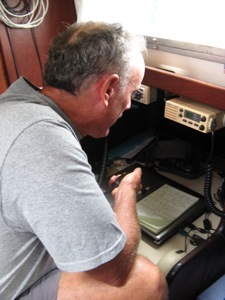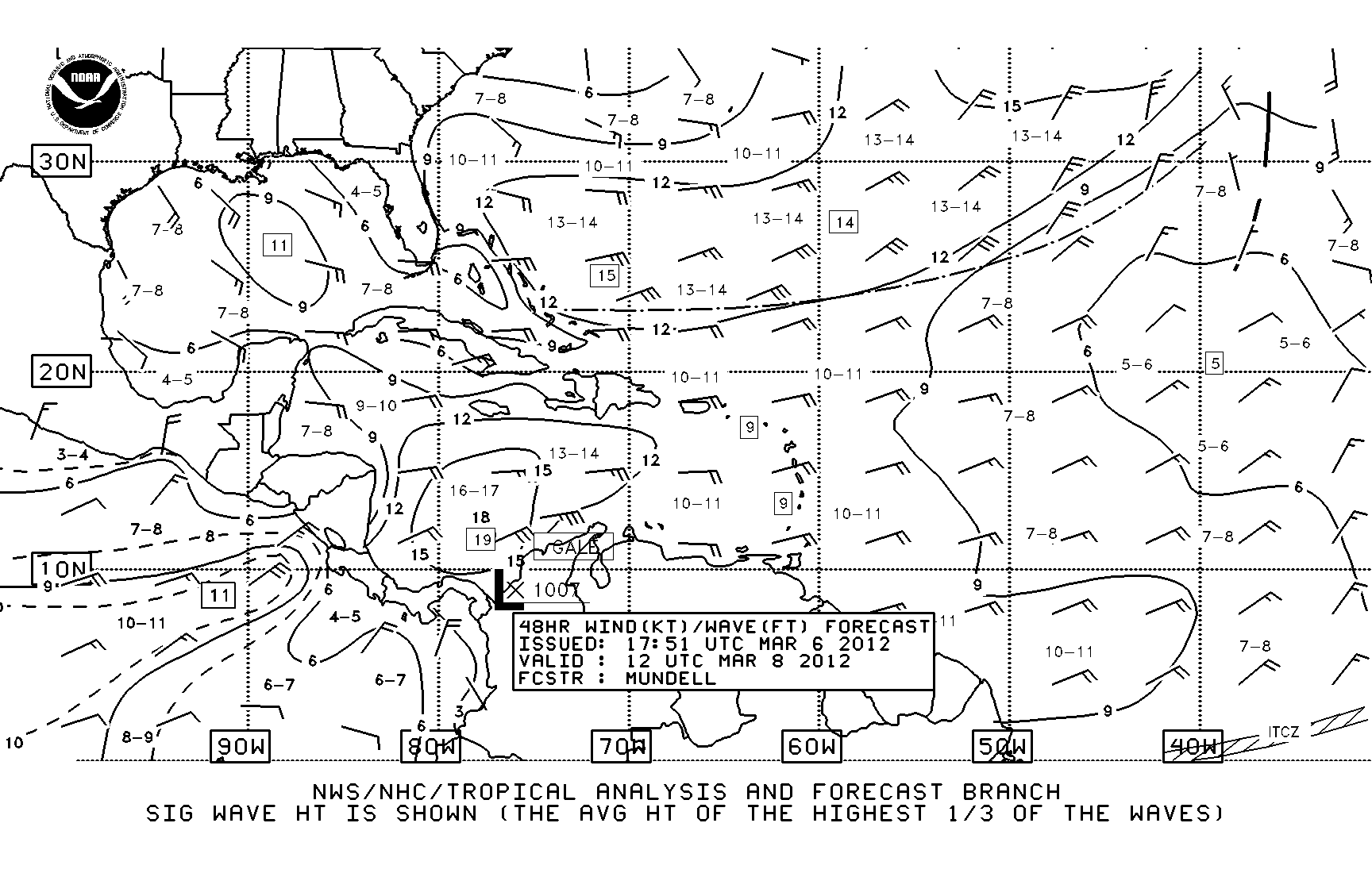Cruising World Magazine ran my SSB Etiquette article (click here for the link to the CW online version) in March 2010 … one of the things that drives me NUTS aboard is the lack of courtesy and radio etiquette. Cruisers that wouldn’t think of cutting someone short in a face to face conversation don’t worry about barging in and talking right over someone else’s conversation. Sometimes getting their e-mail is FAR more important than any other cruiser’s right to hear the only weather they get over the morning cruiser’s net. Why is it that courtesy seems to go out the window when it comes to the radio? Here’s the article published by CW:
*************
SSB Etiquette
Have you experienced the aggravation of trying to listen to an important passage-weather forecast, only to be eclipsed by the infamous e-mail interference? Marine single-sideband radio and amateur, or ham, radio have been around for years, but only recently have they become so prevalent among cruisers, most likely due to technological advances in radios and computers and the increasing affordability of each. Combined with a modem, the result is technology that allows sailors to have access to e-mail via SSB radio that simply wasn’t possible until recently. And as SSB radios have increased in popularity, so, too, has there been a concomitant rise in the frustration levels in many anchorages.
These days, anchorages are filled with cruisers with SSB radios all wanting to check e-mail, get weatherfaxes, participate in radio nets, and chat with their friends in faraway places. As anchorages grow increasingly crowded, SSB/e-mail interference is a growing aggravation for everyone. The following are 10 simple tips that will help keep the SSB airwaves free of interference and frustration.
Listen First
Listening before transmitting is the most important rule of radio usage. Make sure that no one else is already using the frequency. And don’t be fooled by momentary silence; some transmissions are silent for a full 4 seconds between bursts. Listen for a while. It can be difficult to determine through the interference if the frequency is in use. Obviously, if you hear voices, it’s busy. If you hear a chirping noise, it’s a Pactor III transmission; if you hear a rasping noise, it’s a Pactor II transmission. All mean that the frequency is busy. And, obviously, if you hear the familiar dits and dahs of a Morse-code transmission, go find another frequency. The SailMail Association sums up the cardinal rule of SSB operation perfectly: “Not listening first or attempting to connect on a frequency that is already in use is counterproductive, lubberly, pointless, rude, un-shipmatey, and violates international telecommunications law (as well as common sense).”
Off-Hours E-mail
Onboard e-mail is a luxury that’s quickly becoming regarded as a necessity. Unfortunately, e-mail causes most of the aggravation and frustration. Many cruisers tune in to a morning cruisers net or weather forecast early in the day. Accessing e-mail early in the morning creates enough interference that those listening to weather or cruisers nets hear only e-mail chirping or rasping that obliterates voice transmissions. Timing varies in every anchorage, but most morning nets and weather transmissions occur between 0600 and 0900. Sending your e-mail before or after those hours is an easy way to avoid annoying the whole anchorage with your interference.
Proximity Exacerbates Interference
If you attempt to get e-mail in the same anchorage as boats that are attempting to listen to a net or the weather forecast, the interference created will override the net no matter what frequency you use. Don’t assume that because you use a frequency to retrieve your e-mail that differs from the frequency of the radio net that you won’t be interfering. Proximity to other boats has more to do with interference than frequency. Again, the polite policy is simply not to send your e-mail while others are listening to nets or the weather.
Respect Radio Rights
A good cruisers net provides an opportunity to check for emergency, medical, or priority traffic and can be the vital link in a true emergency. Nets can also be the sole source of weather for some cruisers, an important conduit for information exchange about, say, needed engine parts, and a “what’s happening” compendium of an anchorage’s dizzy social swirl. Always respect the right of others to get the information they need via the net.
Don’t Be a DJ
Being a volunteer net controller is fun and provides a good service for other cruisers. However, please remember that the true purpose of a net is to assist in any emergency as well as provide weather information. Recently, and much to the dismay of many a cruiser, some net controllers are playing songs before their broadcasts or including what they think is entertainment. A limited amount of this may liven up the daily net, but keep in mind that it’s illegal to broadcast such content on any SSB or ham band, and that definitely includes playing your favorite ABBA or Johnny Cash tunes.
Watch Your Frequency
When requesting further information during a net, remember to switch to a frequency sufficiently removed from the net so you won’t create interference. Don’t just move a couple of frequencies and think that you’re now far enough away. Everyone else wants to continue to listen to the net.
Charge Your Batteries
Fully charge your batteries before using the radio. Marine SSBs don’t function at their best with even slightly low batteries, particularly with e-mail. Consider running your diesel or another quick-charge strategy to top off your batteries before attempting to transmit or get e-mail. If others are reporting that your voice is garbled or if you can’t get a connection to a SailMail or Winlink frequency, the first thing to check is your batteries.
Reduce Interference
Electrical interference aboard can make getting a frequency for e-mail almost impossible, and it can clutter voice transmissions so you sound like Donald Duck or are reduced to nothing but static. When using the SSB, run your laptop from its battery, shut off the inverter, and turn off the refrigerator. In fact, you should consider shutting off everything on your electrical panel. Anything electrical might create interference. A good test is to listen to the SSB while turning different electronics on and off. This way, you can isolate the interference caused by each device. If you’re under way, don’t forget that interference can work both ways. Many cruisers report that using their SSBs causes their autopilots to forget where to steer.
Propagate
Using a software propagation program to determine which frequencies are optimal for transmitting e-mail reduces your frustration in finding the quickest frequency to retrieve your e-mail. The tool is very easy to use. It reads the station you’ve selected and shows the time of day and the best frequencies in a color-coded graph. If you don’t have one, a free propagation tool is available from Airmail (www.airmail.com).
Power Down
Consider reducing power to 50 watts to reduce interference with nearby vessels. A reduction of power along with a fully charged battery will have minimal effect on your e-mail transmission, and according to SailMail, some evidence suggests that reduced power actually improves e-mail transmissions by reducing overall interference.
If we all follow these simple steps, our single-sideband-radio and ham-radio interactions will be better off. But if a boat in your anchorage continually interferes with nets or weather transmissions, please consider it an educational opportunity. It’s possible that they’re simply unaware of the interference they’re causing during the morning net. So hop in your dinghy and meet your neighbor. You never know, you may meet new friends, be invited for sundowners, and solve the interference problem all in one visit.
CW: Jan S. Irons has been a net controller for both the Northwest Caribbean Net and the Panama Connection Net. She and her husband, David, are currently sailing their 1985 Passport sloop, Winterlude, in the San Blas islands and along Panama’s Atlantic coast.














I AGREE!! I bugs the hell out of me too!!